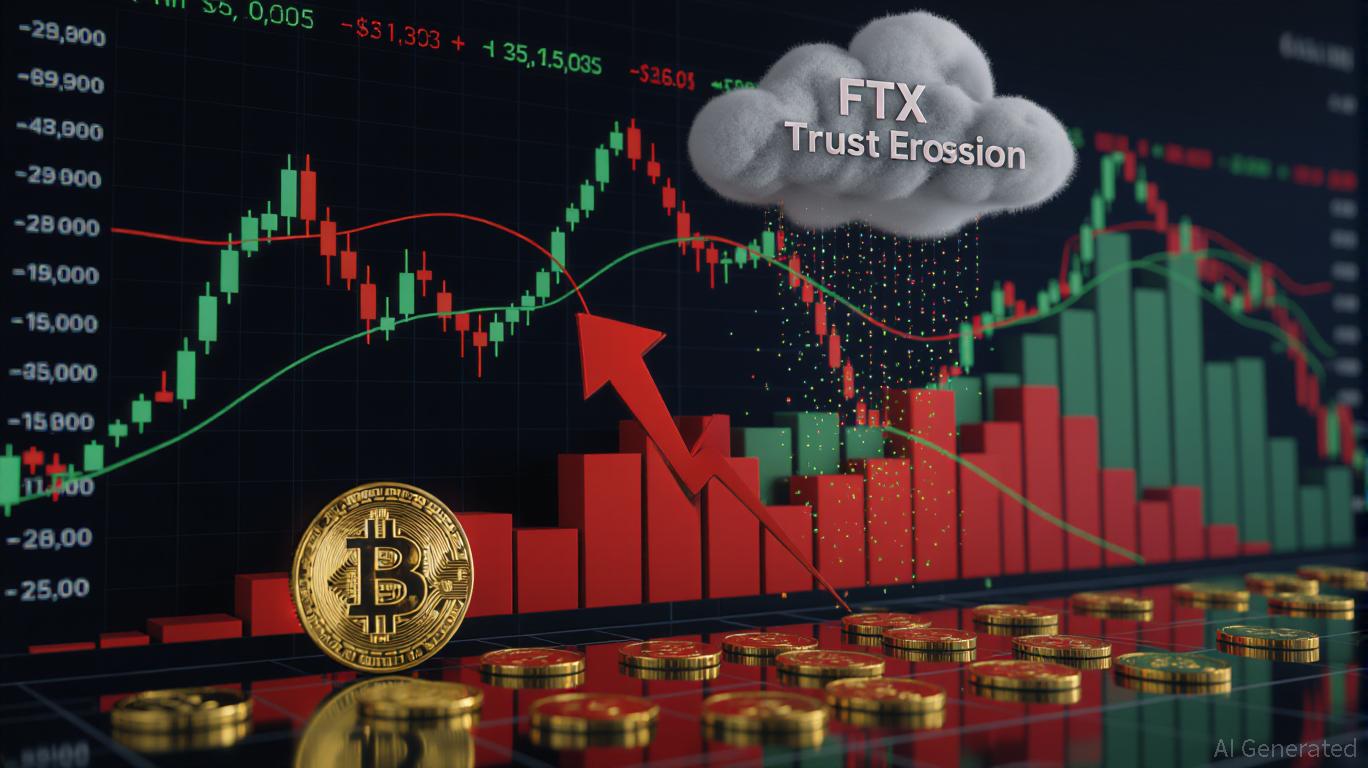U.S. and U.K. Form Joint Taskforce to Align Cryptocurrency Regulations, Supported by Ripple Technology
- The U.S.-U.K. Transatlantic Taskforce, backed by Ripple, aims to harmonize digital asset regulations and boost cross-border financial collaboration through aligned frameworks for stablecoins and tokenization. - Ripple leverages its dual market presence to bridge regulatory gaps, promoting its stablecoin RLUSD and ZKP/KYC tools as solutions for institutional adoption and compliance in fragmented markets. - The 180-day initiative prioritizes joint regulatory sandboxes, mutual compliance standards, and XRP’

Ripple, a prominent provider of blockchain infrastructure, has taken a leading role in the newly formed U.S.-U.K. Transatlantic Taskforce for Markets of the Future. This initiative is designed to synchronize digital asset regulations and promote international financial cooperation. Announced during U.S. President Donald Trump’s visit to the U.K. in September 2025, the taskforce unites policymakers, regulators, and industry experts to tackle major issues in the crypto sector, such as stablecoins, tokenization, and cross-border market entry. Cassie Craddock, Ripple’s U.K. Managing Director, highlighted the company’s influential position in guiding the taskforce, utilizing its operations in both countries to close regulatory and practical divides Ripple Exec Spots New Opportunities With Transatlantic Crypto Taskforce [ 1 ].
The main goals of the taskforce are to harmonize capital market regulations, simplify international capital raising, and create unified standards for stablecoins and tokenized assets. With a 180-day deadline for initial proposals, the group aims to ease compliance challenges for businesses working across both regions. Ripple has underscored its ability to support these efforts, especially through its stablecoin, Ripple USD (RLUSD), which could become a preferred option for regulated, interoperable cross-border payments Ripple Joins Trump-Era US-UK Taskforce to Shape Global Crypto [ 2 ]. The company’s proficiency in zero-knowledge proofs (ZKPs) and know-your-customer (KYC) solutions is also likely to appeal to institutional clients, helping address privacy and regulatory requirements in a fragmented environment Ripple Exec Spots New Opportunities With Transatlantic Crypto Taskforce [ 1 ].
Stablecoins are a central concern for the taskforce, with regulators from both countries working to align oversight systems to prevent regulatory loopholes and strengthen financial stability. Both the U.K. and U.S. see unified rules as a way to streamline cross-border payments and draw institutional investment into digital assets. For Ripple, this opens doors to deepen relationships with financial institutions, using RLUSD as a settlement mechanism for tokenized securities and real-world assets (RWAs). The company’s recent partnership with Franklin Templeton and DBS on institutional token lending highlights its drive to grow in these sectors Ripple Joins Trump-Era US-UK Taskforce to Shape Global Crypto [ 2 ].
The initiative also tackles broader tokenization challenges, such as the development of standardized custody models and delivery-versus-payment (DvP) systems. Ripple’s
The taskforce’s schedule and objectives include creating joint regulatory sandboxes, shared environments for testing blockchain-based financial products, and mutual recognition of compliance protocols. Ripple has pushed for balanced regulations that encourage innovation while managing risks, aligning with the U.S. Treasury’s supportive approach to crypto during the Trump era. The company’s push for regulatory transparency in the U.K. reflects its advocacy in the U.S., where it has long supported frameworks for stablecoins and tokenization Ripple Exec Spots New Opportunities With Transatlantic Crypto Taskforce [ 1 ].
The market’s reaction to the taskforce is mixed. Although XRP has recently struggled to surpass the $3 mark, closer regulatory alignment between the U.S. and U.K. could increase institutional trust in digital assets. Ripple’s forecast, developed with BCG, envisions a $18.9 trillion tokenized asset market by 2033, underlining the long-term promise of cross-border financial infrastructure Ripple, BCG Project $18.9T Tokenized Asset Market by 2033 [ 4 ]. Nonetheless, issues like inconsistent custody practices and varying smart contract standards remain, necessitating coordinated solutions to unlock the industry’s full potential Ripple, BCG Project $18.9T Tokenized Asset Market by 2033 [ 4 ].
The U.S.-U.K. taskforce marks a significant move toward global regulatory consistency in the digital asset space. By removing barriers to international operations and encouraging advances in tokenization, this initiative could become a model for worldwide collaboration. Ripple’s presence in both markets enables it to help shape these changes, with its stablecoins and blockchain offerings playing a key role in driving institutional adoption and market growth Ripple Joins Trump-Era US-UK Taskforce to Shape Global Crypto [ 2 ].
Disclaimer: The content of this article solely reflects the author's opinion and does not represent the platform in any capacity. This article is not intended to serve as a reference for making investment decisions.
You may also like
The Unexpected Bitcoin Plunge in November 2025: Causes Behind the Drop and Future Prospects for Cryptocurrency Investors
- The November 2025 BTC crash resulted from Fed tightening, lingering FTX trust erosion, and institutional outflows. - Fed's hawkish liquidity controls and inflation focus created toxic conditions for Bitcoin's low-rate-dependent market. - FTX's unresolved $7.1B payouts and $20B institutional exodus since 2022 amplified panic selling through trust deficits. - Crypto investors must now wait for Fed policy clarity and prioritize transparent platforms with regulatory compliance.

Bitcoin Updates Today: Fed Navigates Uncertainty as December Rate Cut Remains Unclear
- Market expectations for a Fed rate cut in December dropped to 52% from 95% a month ago, reflecting deepening policymaker divisions. - Hawks like Collins emphasize inflation risks, while doves argue easing is needed to avoid restrictive policies amid weak labor data. - A government shutdown delayed critical economic reports, complicating decisions as structural shifts demand nuanced policy responses. - Bitcoin gains were capped by reduced cut odds, while broader markets remain sensitive to Fed signals on

Solana News Update: Solana’s Fast Network Draws $1.5 Billion in Stablecoin Growth as USDC and USDT See Significant Increases
- Circle mints $500M USDC on Solana , leveraging its 4,000 TPS speed and $0.002 fees to boost DeFi liquidity. - Solana's 2.4M active addresses and 83M transactions highlight its appeal as Ethereum's high-throughput rival. - Tether simultaneously issues $1B USDT on Ethereum , contrasting with Solana's retail-friendly low-cost model. - Institutional adoption grows via Solana Staking ETF and major firm participation, challenging Ethereum's upgrades. - $1.5B stablecoin surge reflects demand for cross-chain sta

Fed's Policy Direction Shifts: Balancing Prudence and Swift Action in Crucial December Decision
- Fed faces 52% market odds of 25-basis-point rate cut at Dec 10 meeting, down sharply from 95% a month ago amid internal divisions. - Key officials like Collins and Kashkari oppose further easing without clearer labor market deterioration or inflation control below 3%. - Government shutdown delays critical data, forcing policymakers to rely on incomplete information and private-sector indicators. - Uncertainty risks asset markets: Bitcoin stagnates near $103k while real estate and growth stocks face headw
